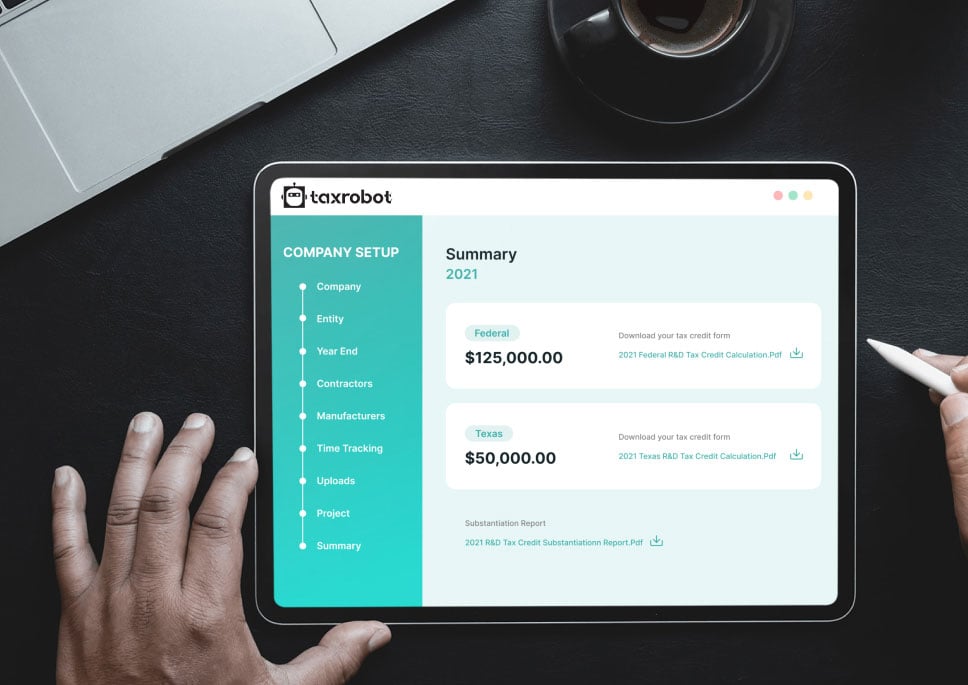Illinois R&D Credit
Get the most out of the Illinois R&D credit with TaxRobot.
Maximize your State Credits today!
Put the R&D tax credit process on autopilot.
Trusted By:








Illinois R&D Credit
Discover your eligibility for Illinois R&D tax credits and supercharge your enterprise.
Are R&D Credits Available in Illinois?
Illinois has many ways through which it encourages the development of businesses within the state. One of these is through a program designed to incentivize research and development via tax credits. So, yes, R&D tax credits are available in Illinois.
However, this is not an automatic credit applied to a tax bill. Companies need to qualify and apply for the credit to obtain it. This is a process that starts with ensuring the company would even qualify in the first place. Then, it continues with determining how much credit the company would receive. Once this happens, the application can be submitted, and, pending approval, the credit is given.
Illinois Research and Development Tax Credit
The Illinois Research and Development Tax Credit is a non-refundable research credit. It is based on the federal research and development tax credit but has a few differences that make it unique to Illinois. Specifically, the calculation for it is different, as it equals 6.5% of the qualifying research expenses that exceed the base amount. These expenses also have to take place within Illinois, and any expenses outside of Illinois do not count. This base amount is also calculated differently, as Illinois defines it as the average of the qualifying research expense made across the three tax years immediately preceding the one in question.
One great thing about this credit is that it can be carried forward. Specifically, it can be carried forward for five years.
Right now, the credit program is set to run until January 1st, 2027. However, it has been extended in the past and, with this in mind, may be extended in the future. However, there is no guarantee this will happen.
Federal R&D Credit
Many aspects of the Illinois R&D tax credit are based on definitions from the federal R&D tax credit. This includes the definition of qualifying expenses and some aspects of how the credit is calculated. So, those interested in applying for the Illinois credit or the federal credit should be fully aware of everything laid out in section 41 of the IRS code.
Business Qualifications
Many businesses across the economic spectrum qualify for the Illinois R&D tax credit. These include companies in agriculture, pharmaceuticals, machinery, and more. They simply need to have the appropriate qualifying expenses in order to qualify.
In addition, partners and shareholders of Subchapter S corporations can also take advantage of this credit. This relates to the income and their share of the income.
Qualifying Expenses
Illinois essentially uses the same definition for qualifying research expenses that the federal government uses. This is helpful, as understanding the federal definition makes understanding the Illinois definition much easier.
These expenses include many expenditures under the umbrella of research and development or research and experimentation. This includes wages paid for employees conducting these activities, supplies purchased to make these activities possible, payments to contracted researchers, and even payments made to scientific organizations and educational institutions.
Get Help Making the Most of the Illinois R&D Credit with TaxRobot
With so much to calculate regarding both the Illinois R&D credit and the federal R&D credit, applying for these credits can be a headache. Plus, if something is wrong with the application, getting the credits may be difficult or even impossible.
Because of this, it is best to trust the professionals at TaxRobot with a matter as serious as this. Our entire company is focused on helping companies obtain these tax credits. To do this, we provide tax consultation and use our software to help with the application process. Together, these let us help companies get the most from these credits.
How Much Could You Save?
Curious to see how much you could save with the R&D tax credit? Get an estimate with our calculator quickly and easily.
Take a sneak peak

- Limited Time Offer
- Simple Onboarding
- Easy to Use
R&D Tax Credits FAQs
The four-part test as outlined in the Internal Revenue Code is used to determine qualified R&D activity.
The Four-Part Test
1). New Or Improved Business Component
Creation of a new product, process, formula, invention, software, or technique; or improving the performance, functionality, quality, or reliability of existing business component.
- Construction of new buildings or renovation of existing buildings
- Invention of a software application
- Manufacturing of a new product or the improvement of the production process for an existing product
- Creation of design documentation
2). Technological In Nature
The activity fundamentally relies on principles of the physical or biological sciences, engineering, or computer science. A taxpayer does not need to obtain information that exceeds, expands or refines the common knowledge of skilled professionals in a particular field.
- Physics (relationship between mass, density and volume; loading as the
result of gravitational attraction) - Engineering (mechanical, electrical, civil, chemical)
- Computer science (theory of computation and design of computational systems)
3). Elimination Of Uncertainty
Uncertainty exists if the information available to the taxpayer does not establish the capability or method for developing or improving the business component, or the appropriate design of the business component.
- The capability of a manufacturer to create a part within the specified tolerances
- The appropriate method of overcoming unsuitable soil conditions during construction
- The appropriate software design to meet quality and volatility requirements
4). Process Of Experimentation
A process designed to evaluate one or more alternatives to achieve a result where the capability or method of achieving that result, or the appropriate design of that result, is uncertain as of the beginning of the taxpayer’s research activities.
- Systematic process of trial and error
- Evaluating alternative means and methods
- Computer modeling or simulation Prototyping Testing
The R&D tax credit is one of the most misunderstood tax incentives available. Considering the myriad of industries and activities that legally qualify for the credit, the term “research and development” is a misnomer. Additionally, the R&D tax credit requires specialized knowledge and technology to identify and calculate the incentive properly.
Companies of various industries are unaware that they are eligible to claim the R&D tax credit. Under the Internal Revenue Code’s definition of R&D, many common activities qualify. You can get tax benefits for industries including software, technology, architecture, engineering, construction, manufacturing, and more.
The R&D tax credit can be claimed for all open tax years. Generally, open tax years include the prior three tax years due to the statute of limitations period. In certain circumstances, the law allows businesses to claim the R&D tax credit for an extended period of time. It is common for companies to amend previous tax years to claim this benefit and reduce the maximum amount of tax liability.
Partnerships and S corporations must file this form to claim the credit. The credit will flow from the Form 6765, to the Schedule K-1, to the Form 3800 on the individual’s tax return. For individuals receiving this credit that have ownership interest in a partnership or S corporation, Form 6765 is not required on the individual return.
Individuals claiming this credit can report the credit directly on Form 3800, General Business Credit if their only source for the credit is a partnership, S corporation, estate, or trust. Otherwise, Form 6765 must be filed with the individual’s tax return (e.g. sole proprietorship).
For tax years prior to 2016, the credit can be used to reduce the taxpayer’s regular tax liability down to the tentative minimum tax. The credit cannot be used to offset alternative minimum tax. Beginning in tax year 2016, eligible small businesses have expanded utilization for the credit. For these eligible small businesses, the regular tax liability can offset alternative minimum tax using the “25/25” rule.
What our customers have to say
I highly recommend TaxRobot to anyone considering an R&D Tax Credit software to complete their analysis.

We decided to switch to TaxRobot… Best decision we’ve ever made. More affordable, and less complicated.

I couldn’t believe how easy it was! In under an hour, we saved enough money to hire a new employee.
